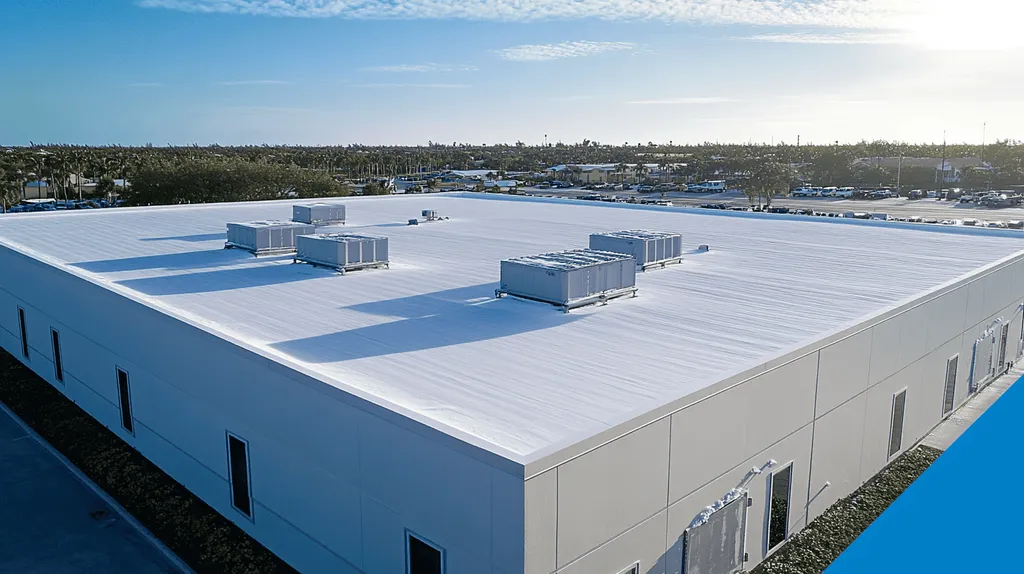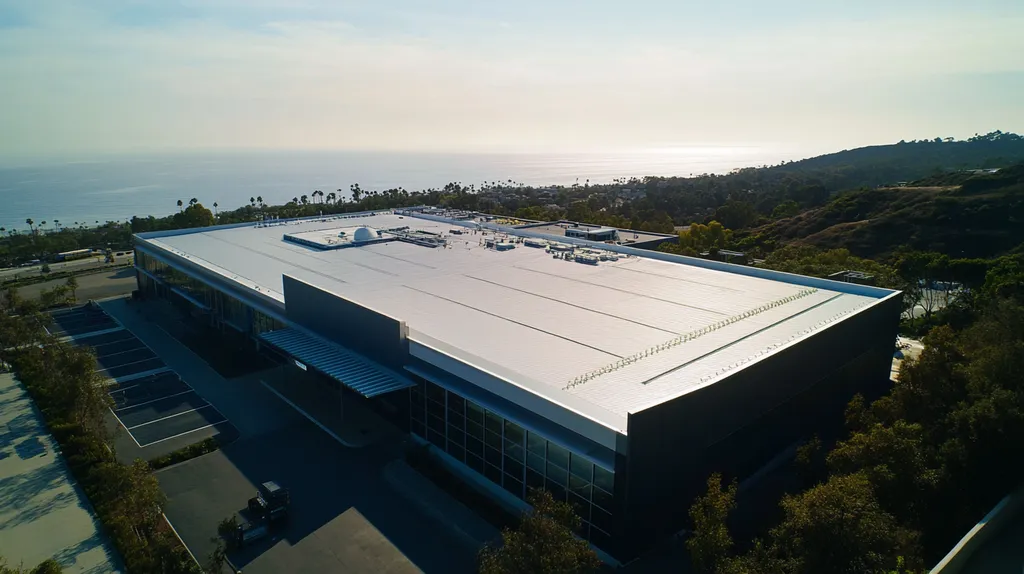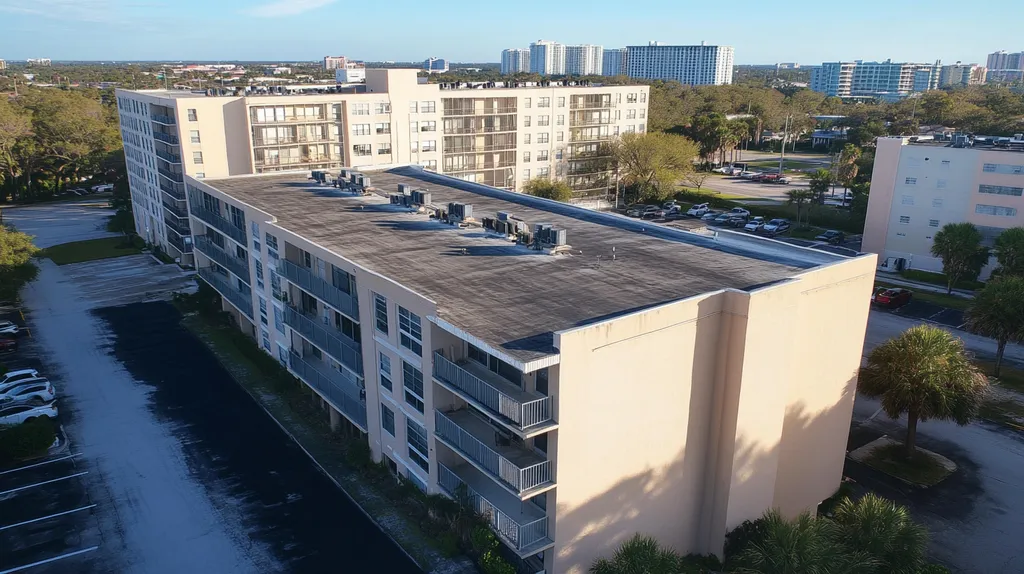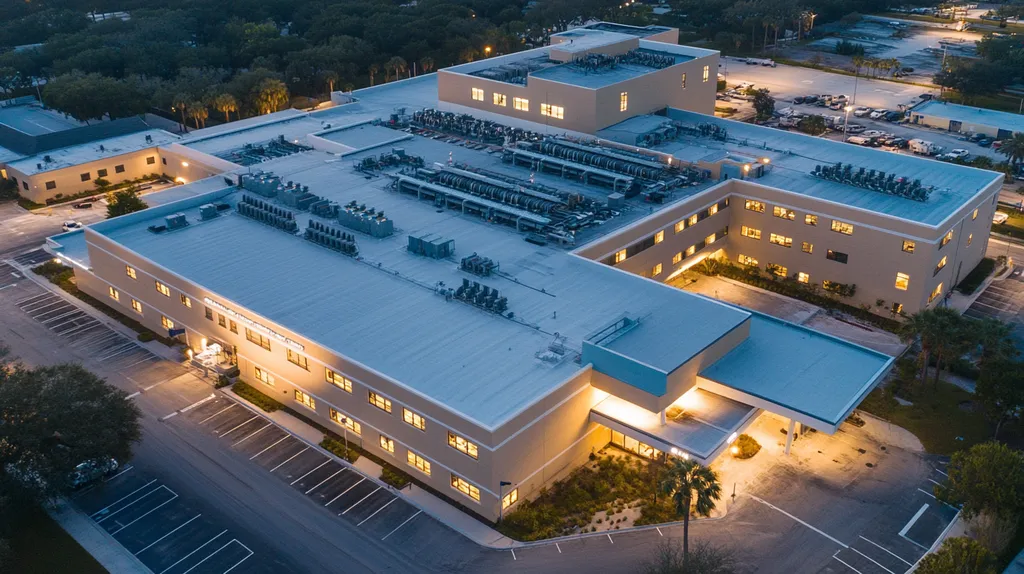In the high-stakes world of commercial roofing, overlooking maintenance requirements specific to different roof types leads to catastrophic failures, with industry data showing 90% of premature roof replacements stem from inadequate upkeep.
From traditional built-up systems to modern single-ply membranes, each roofing type demands its own specialized care routine – yet property owners often apply a one-size-fits-all approach to maintenance.
This comprehensive guide examines the distinct maintenance needs across major commercial roof types, equipping facility managers with essential knowledge to protect their roofing investments and avoid costly emergency repairs.
SECTION 1: FUNDAMENTAL CONCEPTS
Recognizing the distinct maintenance needs of different roof types is vital for property owners and facility managers. Overlooking these specific requirements can lead to expensive repairs and the premature failure of roofing systems. For instance, while a flat roof may require more frequent inspections to address pooling water, a sloped roof may need less oversight but still benefits from regular maintenance. This section will explore essential roof types and their applications, the impact of climate and environmental factors, and the importance of adhering to building codes and regulations.
Roof Types and Applications
Commercial roofs come in various types, each presenting unique maintenance challenges. The most prevalent include built-up roofing (BUR), modified bitumen, single-ply membranes, and metal roofs. BUR systems, made up of multiple layers, can develop problems like blistering or cracking, necessitating vigilant inspections and upkeep.
Single-ply membranes, including TPO and PVC, are favored for their lightweight and easy installation. However, they demand frequent seam inspections to catch potential leaks early. Likewise, while metal roofs are known for their durability, they are not immune to rust, requiring a tailored maintenance routine to ensure their longevity.
Understanding the distinctive features and obstacles that each roofing type presents is critical for crafting an effective maintenance plan. By aligning maintenance schedules with the specific requirements of each roof type, property owners can significantly enhance both the performance and lifespan of their roofing systems.
Climate and Environmental Factors
The climate in which a property is located plays a crucial role in determining maintenance needs for various roof types. For instance, areas that experience heavy snowfall can add significant weight to flat roofs, potentially causing drainage issues. A flat roof that is not regularly maintained in these conditions can suffer from water infiltration and serious structural damage.
Moreover, the sun’s UV radiation can degrade roofing materials, particularly those installed on flat or low-slope designs. Routine maintenance should include assessments for damage caused by sun exposure, especially in sunnier, warmer climates.
Environmental factors, such as nearby trees, can also complicate roof maintenance. Branches can drop debris, clogging gutters and drains, leading to water pooling and damage. Regular debris clearance is essential to maintain proper drainage and protect the integrity of the roof.
Building Codes and Regulations
Building codes and regulations govern many aspects of commercial roofing, from materials used to maintenance practices. Compliance with these codes is essential—not only for the safety of the occupants but also to avoid potential legal ramifications. For example, certain areas may mandate fire-resistant materials, impacting roofing design choices.
Local regulations often stipulate maintenance protocols, including mandatory inspections and routine cleaning. Ignoring these guidelines can lead to inspections failing and even fines, complicating relationships with insurance providers in the event of roofing failures.
Staying informed about local codes is a proactive measure to ensure that a property’s roofing system remains safe and compliant. Continuous education and training for facility managers regarding regulatory updates can strengthen overall maintenance practices and minimize risks linked to non-compliance.
SECTION 2: SYSTEM COMPONENTS
Understanding the building blocks of various roofing systems is essential for property owners and facility managers. Each roof type—whether built-up, single-ply, or metal—comes with its own unique materials and engineering characteristics that shape their maintenance requirements. For example, flat commercial roofs can trap water, creating a risk for leaks, while sloped roofs are designed to channel water away more effectively. Recognizing these distinctions can lead to substantial cost savings and less hassle for property owners in the long run.
Roofing Materials and Properties
The choice of roofing material directly impacts how maintenance is conducted. Asphalt shingles, while common, are often less durable than metal roofs, which means they can require more frequent repairs. On the other hand, high-quality membranes used in single-ply roofs are designed to endure harsh weather conditions and typically necessitate less ongoing care.
Materials also differ significantly in their thermal properties. For instance, insulated roofs can enhance energy efficiency, helping to lower operating costs over time. Property owners should be aware of these properties to make informed choices regarding their maintenance schedules.
Some materials, such as EPDM (Ethylene Propylene Diene Monomer), are known for their durability, but they require careful installation to avoid long-term issues. Poorly executed installations can lead to accelerated wear, ultimately increasing repair costs.
To ensure effective maintenance strategies, it’s crucial for property owners to consult with roofing experts who can assess the specific properties of materials relevant to their roof type.
Drainage and Water Management Systems
Robust drainage is vital for preserving the integrity of roofing systems. Specifically, flat roofs often necessitate advanced drainage solutions compared to their sloped counterparts. Inadequate drainage can result in accumulated water, which leads to leaks and structural damage.
For optimal performance, commercial roofs should include appropriately designed gutters, scuppers, and downspouts that can handle expected rainfall. For instance, roofs in regions that frequently experience heavy rain require more intricate drainage systems to prevent standing water.
Neglecting the maintenance of drainage systems can lead to costly repairs down the line. Regular inspections to check for blockages are essential, as they help identify potential issues before they escalate.
Implementing a consistent schedule for cleaning gutters and downspouts is critical. This proactive approach has a direct impact on the roofing structure’s longevity, reducing the risk of unexpected failures.
Insulation and Structural Elements
Insulation is a key component that significantly affects a roofing system’s overall performance. With proper insulation, energy efficiency is enhanced, contributing to better thermal regulation and a reduction in heating and cooling costs.
Inadequate insulation can lead to excessive energy consumption, creating a long-term financial burden for businesses. Property owners need to be aware that different insulation materials come with their own specific maintenance needs.
For example, rigid foam boards have different care requirements than fiberglass insulation, which may absorb moisture, leading to further complications. Regular assessments of insulation effectiveness are essential for maintaining energy efficiency.
Moreover, structural elements such as beams and trusses must be routinely inspected for signs of wear or weakness. Vigilant inspections can help identify problems before they escalate, ensuring both safety and the longevity of the roof.
By focusing on effective insulation and structural maintenance, property owners can increase the lifespan of their roofing systems while enhancing the overall value of their properties. Routine evaluations ensure that all components work harmoniously, mitigating the risk of unexpected roof failures.
SECTION 3: IMPLEMENTATION METHODS
Implementing effective maintenance methods for roofing systems is crucial in safeguarding investments for property owners. Alarmingly, nearly 40% of commercial roof failures stem from poor installation practices, underscoring the need for vigilance. By mastering installation best practices, ensuring proper integration with building systems, and enforcing stringent quality control inspections, facility managers can significantly boost the durability of their roofs. This section will explore these essential strategies to empower property owners in their maintenance decisions.
Installation Best Practices
Adhering to installation best practices is fundamental to extending the lifespan of roofing systems. A roof that is installed correctly can outperform its poorly installed counterpart, minimizing the frequency and expense of needed repairs. Utilizing the recommended materials and ensuring appropriate insulation during installation are vital measures to prevent moisture buildup, a leading cause of roof damage.
Moreover, selecting contractors with proven expertise in differing roof types is critical. For example, flat roofs require specialized techniques for effective drainage, distinguishing them from pitched roofs which may have different needs. Implementing these tailored strategies reduces their susceptibility to leaks and failures.
Following manufacturer guidelines is also indispensable. Many manufacturers provide comprehensive installation instructions that play a pivotal role in prolonging the roof’s service life. Ignoring these details can result in a roof that deteriorates far sooner than expected—sometimes within just a few years.
Investing in high-quality materials is a wise decision that pays off over time. Durable membranes and robust fasteners enhance the roof’s resilience against environmental stressors, contributing to a longer-lasting structure. This proactive approach not only mitigates costly disruptions in operations but also enhances the overall performance of the roof.
Integration with Building Systems
Effective integration of roofing systems with building structures is another pivotal implementation method that significantly enhances maintenance efficiency. A well-synced roof can optimize water management and energy efficiency across the entire building, ultimately reducing operational costs. For instance, integrating green roofing technologies not only aids in stormwater management but can also contribute to urban heat reduction, leading to lower energy bills.
Furthermore, a strong connection between the roof and HVAC systems is essential. This integration supports energy efficiency efforts and decreases wear on both systems. Well-designed roofing can even accommodate solar panel installations, resulting in energy savings while providing necessary protection for the roofing materials underneath.
Regular inspections of these integrations are vital for identifying potential issues before they escalate into costly repairs. Property owners should create routine assessments to check how their roofing systems interact with other building equipment, fostering a proactive approach to maintenance.
Clear communication between roofing contractors and building managers promotes smooth integration of different systems. Such collaboration ensures that all components function cohesively, ultimately enhancing the building’s overall resilience and efficiency.
Quality Control and Inspection
Quality control and regular inspections are essential for maintaining a reliable roofing system. These measures help pinpoint vulnerabilities that could lead to premature roof failures. Conducting inspections after significant weather events is particularly important; they can reveal damages requiring immediate intervention, thus preventing minor issues from snowballing into extensive repairs.
Establishing a consistent inspection schedule is imperative. Facility managers should aim for bi-annual assessments, along with immediate checks following extreme weather conditions. This practice ensures that any emerging problems are addressed quickly, fostering a proactive maintenance culture.
Additionally, implementing robust quality control measures during installation significantly affects long-term performance. Ensuring that each roofing component adheres to industry standards minimizes the likelihood of faults down the line. Using detailed checklists during installation serves as a valuable guide for upholding quality.
Engaging third-party inspectors provides an objective evaluation of roofing work and maintenance activities. Their specialized expertise can confirm that both installation and ongoing maintenance practices align with best practices, thereby reinforcing the integrity of the roof for years to come.
SECTION 4: MAINTENANCE REQUIREMENTS
Neglecting regular roof maintenance can lead to costly failures and shorten the lifespan of commercial roofing systems. Statistics reveal that proactive maintenance can extend roof life by 50% or more, making it essential for property owners and facility managers to grasp the specific maintenance needs tied to various roof types. This section highlights the importance of scheduled inspections, the necessity of debris removal, and the tailored care required for different roofing materials.
Scheduled Inspection and Repair
Scheduled inspections are critical for spotting potential issues early, which can save both time and money. Different roof types call for unique inspection frequencies; for example, single-ply membranes require checks at least twice a year, whereas metal roofs may only need annual evaluations.
During these inspections, roofing professionals assess seams, flashings, and the overall integrity of materials. By addressing issues immediately, property owners can prevent water ingress, a common problem that can escalate significantly if ignored. Regular evaluations are also generally more cost-effective than emergency repairs.
A detailed maintenance plan tailored to each roof type is essential to ensure property owners are aware of critical indicators of wear. Keeping meticulous records of inspections not only aids in warranty claims but also demonstrates the roof’s well-maintained condition for insurance purposes.
Employing digital tools and checklists to track inspections enhances accountability and efficiency. Ultimately, a proactive approach to maintenance leads to better budget management and minimizes disruptions to daily operations.
Debris Removal and Cleaning
Accumulated debris poses significant risks, potentially causing mold growth and water pooling—especially on flat roofs. Prioritizing regular cleaning and debris removal is crucial to avoid these problems. For instance, concrete and built-up roofs are particularly vulnerable to debris-related issues that can reduce their lifespan.
Gutters and roof drains should be routinely cleared of leaves, dirt, and other materials to ensure proper water flow. Clogged systems can result in pooling, which can lead to leaks or even structural damage. Different roofing materials might necessitate diverse cleaning methods to prevent harm.
Additionally, removing contaminants like algae and mold is vital. Specific cleaners tailored to the roof material type should be utilized to protect surfaces; for example, specially formulated cleaners for metal roofs help avoid scratches.
Establishing a regular schedule for cleaning and debris removal is not merely an act of maintenance; it’s an investment that enhances the property’s longevity. Engaging professionals with knowledge of various roofing types ensures effective and safe cleaning methods.
Addressing Specific Issues by Roof Type
Each roofing style comes with its own set of maintenance challenges. For example, EPDM roofs can develop punctures from foot traffic or equipment, requiring prompt patch repairs. Conversely, TPO roofs need close monitoring for UV degradation that can lead to brittleness over time.
Built-up roofs can experience issues like blistering as the underlying layers age and moisture gets trapped. Early identification and resolution of these problems are critical in preventing leaks and further damage. Understanding the unique signs of wear for each type enhances proactive management and optimizes repair strategies.
Specific flashing issues at junctions on sloped roofs also warrant attention, requiring tailored maintenance strategies. Regular inspections targeting these vulnerable areas help safeguard roofs against water intrusion.
A comprehensive maintenance program that acknowledges the characteristics of each roofing type empowers property owners to effectively mitigate risks and protect the value of their investments.
SECTION 5: PERFORMANCE METRICS
In the competitive landscape of commercial and industrial real estate, understanding roof performance metrics is not just beneficial—it’s essential. Failing to monitor these metrics can lead to costly repairs and premature roof failures. Studies reveal that buildings with continuous performance monitoring can cut unexpected failures by as much as 40%. By evaluating roof condition, overseeing drainage, and assessing energy efficiency, property owners can make informed decisions that significantly impact their bottom line. This section will explore these critical performance metrics and their implications for proactive roof management.
Evaluating Roof Condition and Age
Regularly evaluating the age and condition of a roof is a cornerstone of effective maintenance. The lifespan of a roof can vary greatly based on its materials; for instance, TPO roofs typically last between 15 and 30 years, while built-up roofs can exceed 30 years with proper upkeep. Scheduling annual inspections, ideally following severe weather events, helps identify wear and tear that may not be immediately visible from the ground.
Inspection professionals will look for signs of distress such as cracks, blisters, and localized damage. Early detection of these problems can prevent minor issues from escalating into substantial repair costs. Documenting these inspections in detailed reports is invaluable; this information aids in tracking the roof’s performance over time, guiding decisions about repairs or replacement.
Overall, a consistent approach to evaluating roof condition and age leads to fewer emergency repairs and enhances the roof’s efficiency.
Monitoring Drainage and Water Flow
Monitoring drainage systems is crucial for maintaining the integrity of any roofing structure. Left unchecked, standing water can inflict severe damage across all roof types, significantly increasing the risk of leaks and structural issues. Flat roofs are especially vulnerable, often necessitating bi-annual inspections to ensure that drains and scuppers remain unobstructed.
To combat drainage issues, property managers should invest in rainwater management systems that efficiently redirect water and reduce flooding risks. Installing rain gauges or flow meters can give a clearer picture of water flow, allowing for timely interventions when blockages occur.
By regularly monitoring drainage and water flow, property owners can not only mitigate potential long-term damage but also ensure compliance with local drainage regulations—keeping operations running smoothly.
Assessing Energy Efficiency and Costs
In today’s cost-sensitive environment, assessing the energy efficiency of commercial roofs is more important than ever. Energy-efficient roofs, whether they feature reflective coatings or green membranes, can lead to substantial energy cost reductions—sometimes up to 25%. Conducting energy audits allows property owners to grasp how their roofs affect heating and cooling expenses.
By comparing energy performance among different roofing systems, property owners can make informed future investment decisions. Evaluating the quality of insulation and thermal resistance is critical for understanding a building’s overall energy efficiency, especially since many older roofs lack adequate insulation, resulting in higher energy bills.
Regularly targeting energy efficiency assessments provides opportunities for upgrades that translate into long-term savings. Investing in high-performance roofing materials is not just a cost; it’s a strategic move aimed at enhancing the property’s value.
In conclusion, integrating evaluations of energy efficiency into roof maintenance strategies is essential for not only optimizing costs but also ensuring sustainable and efficient building operations.
SECTION 5: PERFORMANCE METRICS
Understanding roof performance metrics is crucial for property owners in the commercial and industrial sectors. Monitoring these metrics is not just a preventative measure; it’s a necessary strategy that prolongs the roof’s lifespan and minimizes unexpected, costly repairs. Research indicates that continuous performance monitoring can reduce unforeseen failures by up to 40%. By focusing on roof condition, drainage management, and energy efficiency, owners can make informed decisions that significantly impact overall operational costs. This section explores these essential performance metrics and their implications for effective roof management.
Evaluating Roof Condition and Age
Regular evaluation of a roof’s age and condition is fundamental to effective maintenance. Roof lifespan can vary considerably based on its materials; for instance, TPO roofs typically endure between 15 and 30 years, while built-up roofs can last over 30 years with diligent care. Conducting inspections at least once a year, especially after severe weather, reveals signs of wear that may not be visible from the ground level.
During inspections, professionals should look for cracks, blistering, and other damage indicators. Early detection of these issues can prevent minor problems from escalating into expensive repairs. Adopting a proactive philosophy towards maintenance ensures roofs remain effective and extends their life.
In addition to inspections, maintaining detailed records of the roof’s condition is vital. These reports allow property owners to track performance over time and make informed decisions about whether to repair or replace their roofs. Documented evaluations ultimately contribute to fewer emergency repairs and boost overall roof efficiency.
Monitoring Drainage and Water Flow
Effective monitoring of drainage systems is pivotal for maintaining the integrity of roofing structures. Standing water poses a severe threat, as it can lead to leaks and structural damage across various roof types. Flat roofs, in particular, necessitate bi-annual checks to ensure drains and scuppers remain clear. Properties lacking adequate drainage can experience up to 10% greater deterioration due to water pooling.
To combat drainage issues, property managers should employ rainwater management systems designed to redirect water effectively and minimize flooding risks. Installing rain gauges or flow meters can enhance monitoring capabilities, allowing for prompt action when drainage is compromised.
Frequent inspections of drainage systems mitigate long-term risks and ensure compliance with local regulations, protecting the property from unforeseen liabilities. Proactive drainage management not only prolongs roof life but also significantly impacts overall operational efficiency and cost savings.
Assessing Energy Efficiency and Costs
In today’s economically conscious landscape, assessing a roof’s energy efficiency is more critical than ever. Energy-efficient roofs, whether featuring reflective coatings or green installations, can yield substantial savings, sometimes reducing energy costs by as much as 25%. Conducting comprehensive energy audits allows property owners to evaluate how their roofing systems affect heating and cooling expenditures.
Comparing energy performance across differing roofing systems informs future investment decisions. Understanding the quality of insulation and thermal resistance is essential; many older roofs fall short in insulation, unnecessarily inflating energy bills.
Regular energy efficiency assessments create opportunities for upgrades that can yield significant savings over time. Investing in high-performance roofing materials isn’t merely a cost; it’s a strategic enhancement that increases a building’s value and operational efficiency. Integrating these assessments into maintenance strategies is vital for optimizing costs while ensuring sustainable building practices.
Looking Ahead
With studies showing that 90% of commercial roof failures stem from inadequate maintenance specific to roof type, the stakes for proper upkeep have never been higher.
The evolution from traditional built-up systems to advanced synthetic membranes has transformed how we approach roof maintenance, yet the fundamental principle remains: each roofing type demands its own specialized care routine.
Property owners who implement type-specific maintenance programs consistently see 50% longer roof lifespans and 40% fewer emergency repairs compared to those using generic approaches.
As roofing technology continues advancing, staying informed about proper maintenance requirements for each system type isn’t just good practice—it’s essential for protecting substantial commercial property investments and avoiding catastrophic failures.
FREQUENTLY ASKED QUESTIONS
Q. What are the maintenance needs for commercial roofs?
A. Recognizing the distinct maintenance needs of different roof types is essential. Regular inspections and tailored care can significantly enhance the lifespan of the roofing system, avoiding premature failures and costly repairs.
Q. How do different industrial roof materials affect maintenance?
A. Each roofing material presents unique challenges. For instance, single-ply membranes require frequent seam inspections, while metal roofs need rust management. Understanding these specifics is crucial for proper maintenance.
Q. How often should commercial roof inspections be scheduled?
A. The frequency of inspections varies. For example, single-ply roofs should be inspected bi-annually, while metal roofs may only require annual checks. Regular evaluations help detect issues early.
Q. What are the consequences of neglecting roof maintenance?
A. Neglecting regular maintenance often leads to costly failures and shortens the roof’s lifespan. It’s estimated that proactive maintenance can extend a roof’s life by over 50%, making regular care crucial.
Q. How does climate impact commercial roof maintenance requirements?
A. Climate plays a pivotal role in maintenance needs. Areas with heavy snowfall or high UV exposure require more frequent inspections and specific care tailored to their environmental stresses.
Q. What drainage solutions are essential for commercial roofs?
A. Effective drainage solutions, including well-designed gutters and downspouts, are essential for maintaining roofing integrity. Regular checks ensure that water is directed away efficiently, preventing leaks and structural issues.
Q. What new trends are shaping commercial roof maintenance?
A. New trends include integrating advanced technology for inspections and energy-efficient roofing materials. Innovations such as drones and performance monitoring systems are transforming maintenance strategies for better effectiveness.










